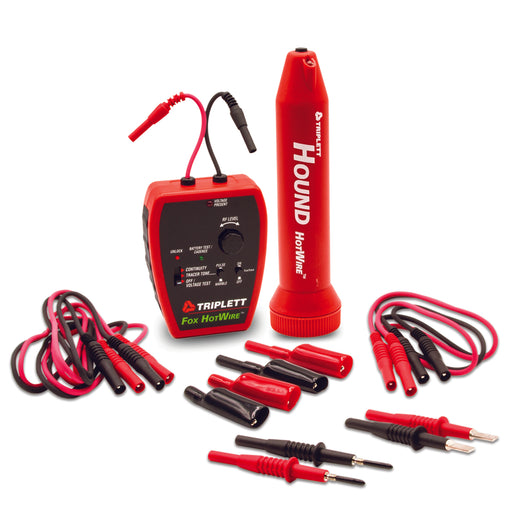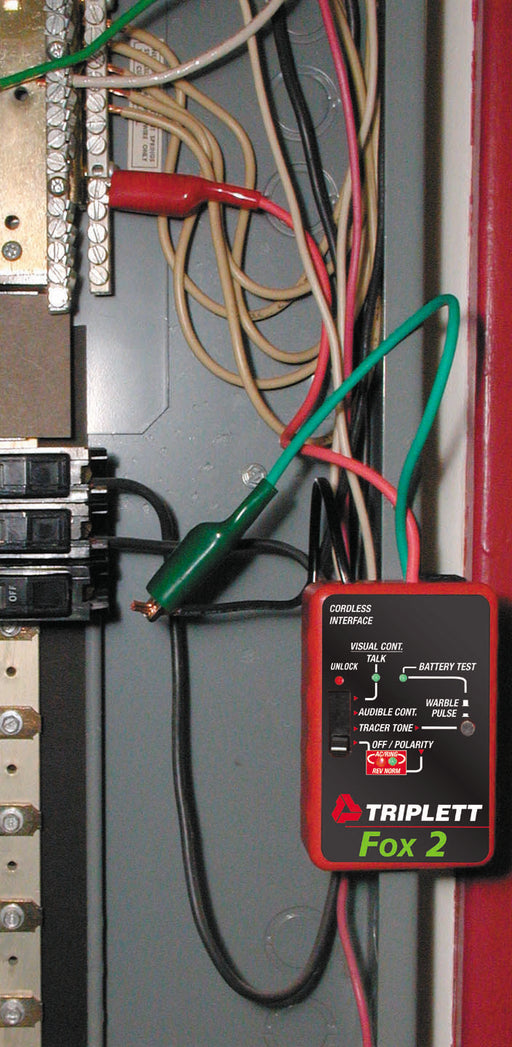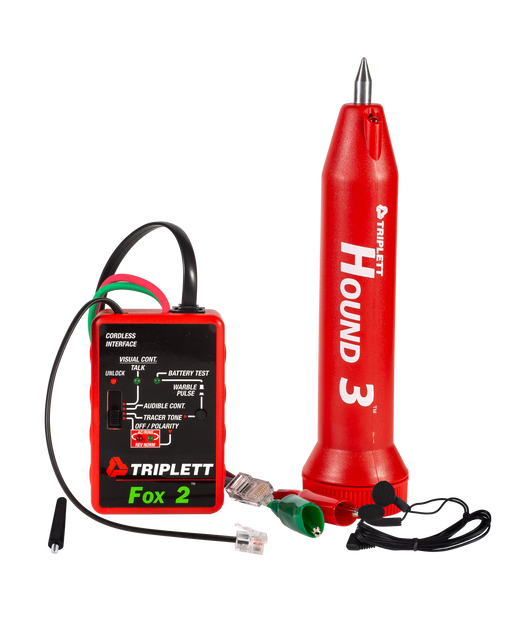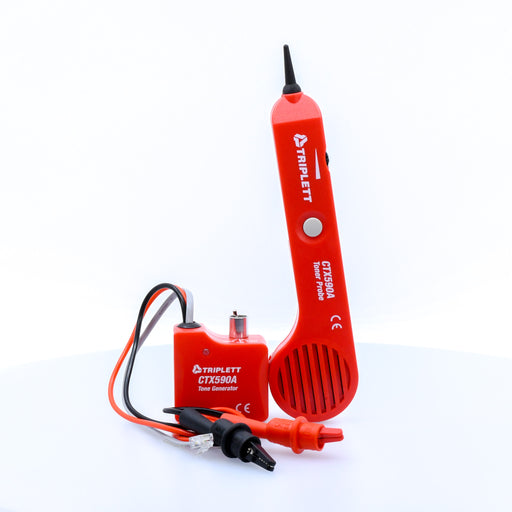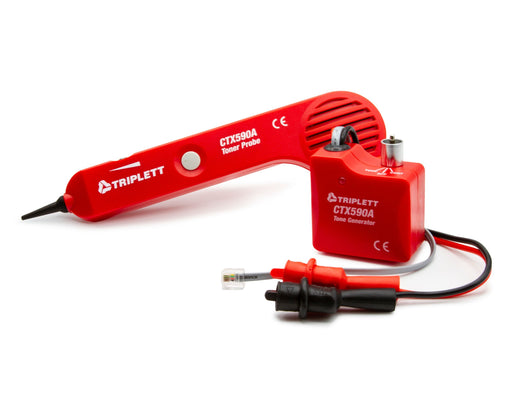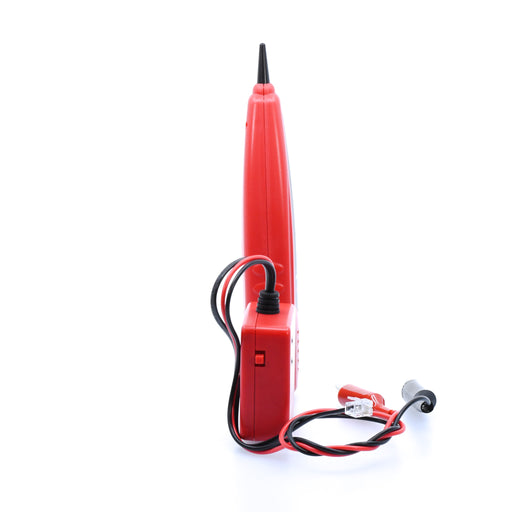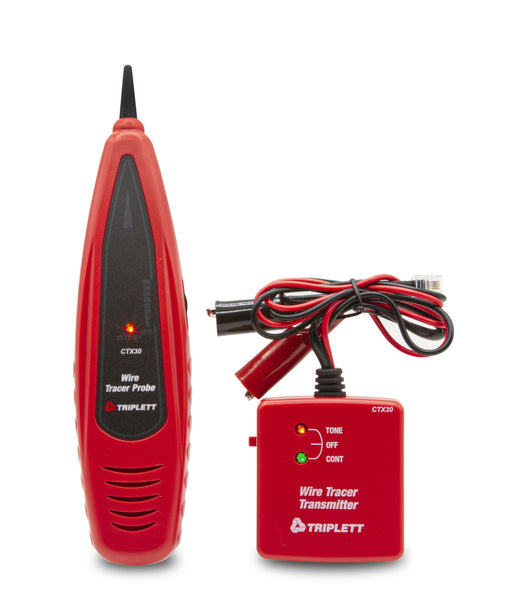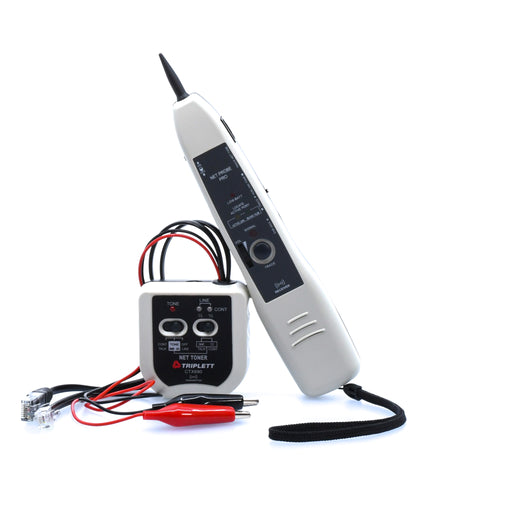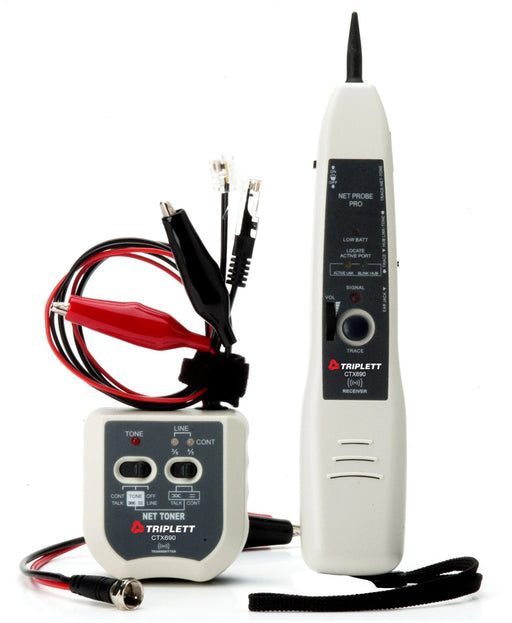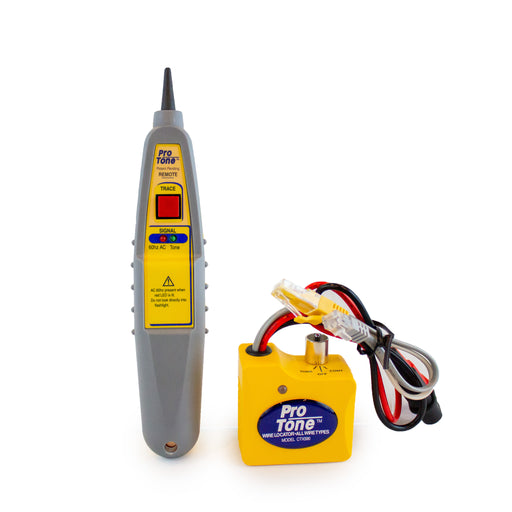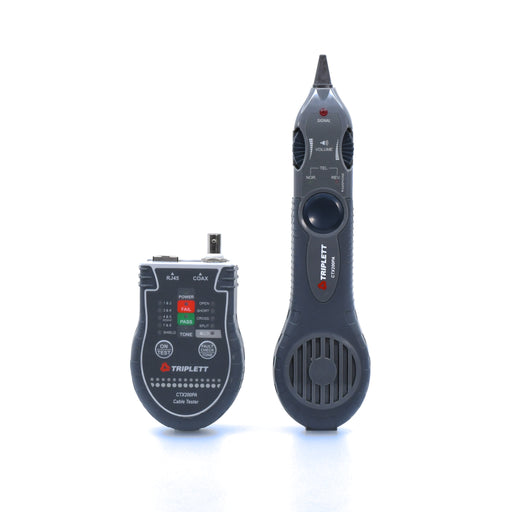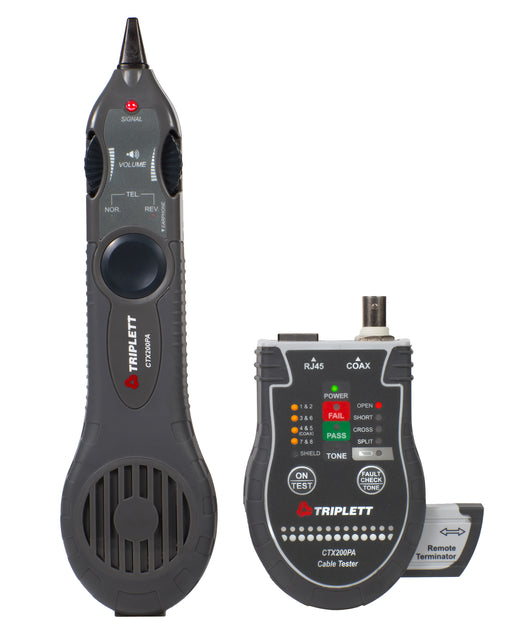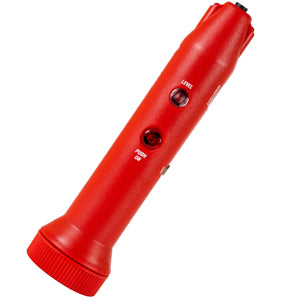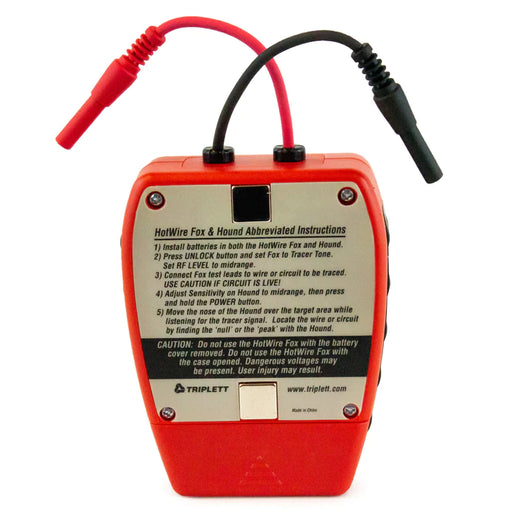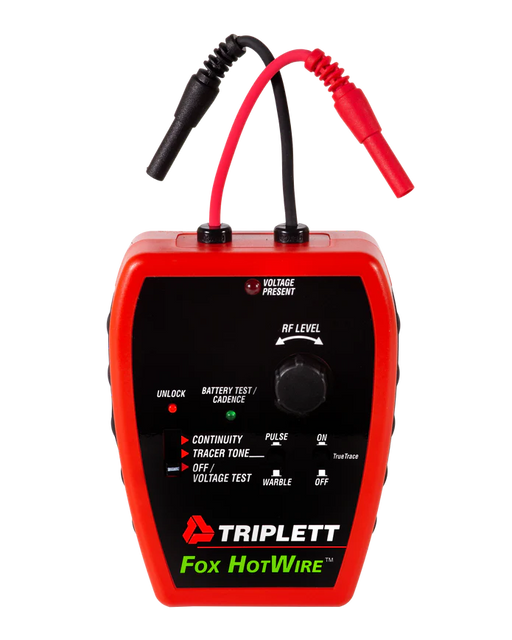
Professional Tone Generator & Probe Kits
Triplett’s tone & probe kits feature our recognized Fox & Hound series. Our tone generator and probe kits can trace various cable and wire types including: twisted pair, LAN, multi-conductor, telephone/alarm and unpowered electrical wire. The tone generators can produce multiple tones including warble and pulse, and they can provide an audible and visual continuity test. These test kits feature built-in LED headlights, which help illuminate dark areas, minimize fluorescent light noise; an earphone jack for quiet and noisy work areas; a bandpass filter that suppresses unwanted frequencies, and a battery cover to protect batteries. The toner and probe kit comprises test leads, pointed probes, flat blades, alligator clips, batteries, and a hard carrying case.
Professional tone generator and probe kits are widely used for testing electronics, electrical, building maintenance, and construction. The electrical wire tracer tone generator in these kits produces an audible tone when they detect wires or cables.
Filters
Categories
-
Building, Maintenance, and Environmental
- Borescopes & Inspection Cameras
- Laser Distance Meters
- Photo & Contact Tachometers
- Manometers
- CO & CO2 Meters
- F Connectors
- Combustible Gas Detector and Pen
- Humidity Indicators & Meters
- Pin & Pinless Moisture Meters
- Thermometers
- Light Meters
- Sound & Noise Level Meters
- Particle Counter
- Thermo Anemometers
- Hygro-Thermometers
- Hygrometer
- Special Kits
- Refractometer
- Coating Thickness Testers
- PH and Conductivity Meters
-
Electrical Test & Measurement
- Analog Meters -Voltmeters
- Clamp Meter
- Digital Multimeters
- Railroad Test Sets
- Voltage & Current Dataloggers
- Magnetic Field Detectors
- AC Voltage Detector
- Continuity Testers
- Test Leads
- Multimeter Case
- GFCI Receptacle Testers
- Electrical Hand Tools
- Non-Contact Voltage Detection Pens
- Circuit Breaker Tracers
- Special Kits
- Megohmmeters - Insulation Testers
- Power Supplies
- Motor & Phase Rotation Testers
-
Security, CCTV & Cabling Equipment
- Security Camera Testers
- CCTV HD LED Test Monitors
- Baluns, Ground Loop Isolators
- HDMI & IP Extenders
- All Cables
- HDMI Cables
- CAT6a Shielded Cable
- Ethernet Network Cables
- CCTV BNC Adapters
- BNC Connectors
- F Connectors
- BNC Compression Connectors
- CAT5 & CAT6 Connectors
- CCTV Coax Connectors
- Modular Connector
- Between Series Adapters
-
Best SellerFree Shipping*Original price $320.00 - Original price $320.00Original price$320.00$320.00 - $320.00Current price $320.00| /
Fox & Hound HotWire™ Live Wire Tone & Probe Kit: Trace Live 120/220VAC Power Lines - (3388)
TriplettIn stock0 Reviews
The Fox HotWire is powered by a 9 volt battery for Low Voltage tracing or it can be powered by the High Voltage line it is toning. Read More > ...
View full detailsOriginal price $320.00 - Original price $320.00Original price$320.00$320.00 - $320.00Current price $320.00| / -
Best SellerOriginal price $160.00 - Original price $160.00Original price$160.00$160.00 - $160.00Current price $160.00| /
Fox & Hound™ Premium Tone & Inductive Amplifier Probe Kit: Overload Protection Up to 120VAC - (3399)
TriplettIn stock0 Reviews
The FOX 2 and HOUND 3 wire tracing kit consists of a premium FOX 2 Tone Generator (Toner) and a newly designed HOUND 3 Inductive Amplifier (Probe)....
View full detailsOriginal price $160.00 - Original price $160.00Original price$160.00$160.00 - $160.00Current price $160.00| / -
Original price $131.00 - Original price $131.00Original price$131.00$131.00 - $131.00Current price $131.00| /
Wire Locator Kit with Inductive Toner Probe and Tone Generator : Traces Various Wire Types - (CTX590A)
TriplettIn stockThe Triplett CTX590A ProTone Wire Locator Kit features a powerful tone generator and probe. The CTX590 functions as a high quality wire locating to...
View full detailsOriginal price $131.00 - Original price $131.00Original price$131.00$131.00 - $131.00Current price $131.00| / -
Original price $44.00 - Original price $44.00Original price$44.00$44.00 - $44.00Current price $44.00| /
Tone and Probe Wire Tracer and Circuit Tester: POTS Line Tip and Ring Testing 24VAC - (CTX30)
TriplettIn stock0 Reviews
Quickly trace various types of unenergized cable including electrical wire, twisted pair, LAN, multi-conductor, telephone, alarm and others. It fea...
View full detailsOriginal price $44.00 - Original price $44.00Original price$44.00$44.00 - $44.00Current price $44.00| / -
Best SellerOriginal price $189.00 - Original price $189.00Original price$189.00$189.00 - $189.00Current price $189.00| /
Network Toner and Probe Kit: Trace Active and Inactive Networks, Live or Dead Phone Lines- (CTX690)
TriplettIn stockThe CTX690 Network Toner and Probe Kit is designed specifically for locating and tracing cables on inactive or active networks, and live or dead ph...
View full detailsOriginal price $189.00 - Original price $189.00Original price$189.00$189.00 - $189.00Current price $189.00| / -
Deal of The Month!Original price $139.00Original price $139.00 - Original price $139.00Original price $139.00Current price $88.00$88.00 - $88.00Current price $88.00| /
ProTone Tone and Probe Kit (CTX590)
TriplettIn stock0 Reviews
The Triplett/ByteBrothers CTX590 ProTone Wire Locator Kit features a powerful tone generator and a filtered, ultra-bright lighted probe. Read More...
View full detailsOriginal price $139.00Original price $139.00 - Original price $139.00Original price $139.00Current price $88.00$88.00 - $88.00Current price $88.00| /Save 37% Save % -
Original price $191.00 - Original price $191.00Original price$191.00$191.00 - $191.00Current price $191.00| /
RJ45 and Coax Tester and Inductive Probe: Traces Wire Types and Performs TI1568 Tests - (CTX200PA)
TriplettIn stockThe CTX200P RJ45/Coax Tester performs a TIA568 test on CAT5/6 network cable (RJ45) with instant PASS/FAIL results — opens/shorts, reversals, split ...
View full detailsOriginal price $191.00 - Original price $191.00Original price$191.00$191.00 - $191.00Current price $191.00| / -
Original price $117.00 - Original price $117.00Original price$117.00$117.00 - $117.00Current price $117.00| /
Fox & Hound HotWire™ Receiver 120/220VAC Power Lines - (3392)
TriplettLow stockThe Fox HotWire is powered by a 9 volt battery for Low Voltage tracing or it can be powered by the High Voltage line it is toning. Read More > ...
View full detailsOriginal price $117.00 - Original price $117.00Original price$117.00$117.00 - $117.00Current price $117.00| / -
Original price $189.00 - Original price $189.00Original price$189.00$189.00 - $189.00Current price $189.00| /
Fox & Hound HotWire(TM) Transmitter 120/220VAC Power Lines - (3382)
TriplettLow stockThe Fox HotWire is powered by a 9 volt battery for Low Voltage tracing or it can be powered by the High Voltage line it is toning. Read More > ...
View full detailsOriginal price $189.00 - Original price $189.00Original price$189.00$189.00 - $189.00Current price $189.00| / -
Best SellerOriginal price $80.00 - Original price $80.00Original price$80.00$80.00 - $80.00Current price $80.00| /
Hound™ 3 Replacement Probe - (3399-hound)
TriplettLow stockThe FOX 2 and HOUND 3 wire tracing kit consists of a premium FOX 2 Tone Generator (Toner) and a newly designed HOUND 3 Inductive Amplifier (Probe)....
View full detailsOriginal price $80.00 - Original price $80.00Original price$80.00$80.00 - $80.00Current price $80.00| / -
Best SellerOriginal price $80.00 - Original price $80.00Original price$80.00$80.00 - $80.00Current price $80.00| /
Replacement Fox transmitter - (3399-FOX)
TriplettLow stockThe FOX 2 and HOUND 3 wire tracing kit consists of a premium FOX 2 Tone Generator (Toner) and a newly designed HOUND 3 Inductive Amplifier (Probe)....
View full detailsOriginal price $80.00 - Original price $80.00Original price$80.00$80.00 - $80.00Current price $80.00| /
Know More About Triplett Tone and probe kits
What is a Tone Generator and Probe?
Tone and probe kits are extremely essential for networking technicians, and they must always carry one with them. Tone generators and probes are simple tools that have evolved with time to include advanced features. An electrical tone generator is a device that converts an electrical signal into a sound signal. The sound signal can be created in various frequencies based on the application requirements. A tone generator tool are used to send a signal from one end of a wire across its length to trace wiring issues or missing wires, unlabeled wires which run into various locations, and have open ends, and so on.
A tone generator and probe, also known as a toner and probe kit, is a pair of handheld tools used for tracing and identifying cables in networking, telecommunications, and electrical systems. The kit consists of two devices: a tone generator and a probe. Here's a brief explanation of each:
Tone Generator: The tone generator is a portable device designed to emit an audible tone or signal onto a specific cable or wire. It is usually connected to the cable or wire using clips or connectors. Once activated, the tone generator introduces a distinctive tone or signal into the cable, which can be easily detected by the probe.
The tone generator serves the purpose of assigning a distinct identifier to the cable or wire, simplifying the process of tracing and identifying specific cables within intricate systems. It proves valuable in tasks like cable tracing, continuity testing, and identifying cable ends.
Probe: The probe is a portable device designed to detect the tone or signal produced by the tone generator. Equipped with a probe tip or sensor, it is positioned near the cables or wires under examination. As the probe approaches a cable carrying the emitted tone, it generates an audible tone or presents visual indicators like LED lights to confirm the signal's presence.
The probe is employed to pinpoint and identify the cable that carries the tone generated by the tone generator. Technicians can achieve this by moving the probe along the cables or wires, enabling them to precisely locate the desired cable. This capability proves invaluable in tasks such as cable tracing, wire identification, and verifying cable connections.
The combination of a tone generator and probe creates a robust toolkit for cable identification and tracing. These tools are widely utilized by network technicians, electricians, and telecommunications professionals to troubleshoot network connections, pinpoint cable faults, verify cable routing, and ensure accurate cable identification within intricate systems. Their effectiveness in these tasks makes them indispensable for professionals working in these fields.
By using the tone generator and probe, technicians can save time and effort in identifying and tracing cables, reducing downtime and improving the efficiency of network or electrical system maintenance and troubleshooting. The utilization of the tone generator and probe allows technicians to streamline the process of identifying and tracing cables, resulting in time and effort savings.
How does a Wire Toner Tracer Work?
Wire toner tracing is a process of locating cables and wires within buildings, walls, and other enclosures. It is often used by electricians, data cabling technicians, and other professionals who need to find and trace specific wires among hundreds in a cable trunk, without the need to either strip or connect the remote end. Wire toner tracers work by sending a signal through the wire being traced. In other words, with the tone generator is connected to the start of the wire(-s), the probe tool produces an audible tone once it identifies the correct wire. This signal can then be detected by the toner tracer's receiver, which is usually handheld. The receiver will emit a sound or light when it is near the signal, making it easier to locate the wire.
What are the applications of electric tone generator and probe tester?
This electrical wire tracer tone generator has diverse applications ranging from identifying network wiring issues to creating sounds for digital versions of instruments such as guitar, piano, and so on. They have been used in music recording studios. They are even used in pest repellent devices that produce certain sound frequencies to get rid of mosquitoes and other pests. They are used in telecommunications as well as television cable companies to trace issues pertaining to the shielding of wires.
What is an electric circuit tracer?
An electrical wire toner tracer basically checks wires that are hard to reach, deep inside walls, remotely located, or underground. A tone and probe tester and tracer kit are used to check the polarity in telecom lines, identify wire pairs and continuity in connections. There are tone generator wire tracers that can determine the wiring issues in a non-contact manner, which is through an audible sound. This offers better accuracy and reduces the possibility of false detection. This kit comprises a toner wire tracer or toner probe, alligator clips, batteries, and a transmitter.
How to trace wire using a toner probe?
An electrical probe tester functions in two steps to trace a wiring issue - first, wherein the tone generator with a certain audio frequency is applied to one end of a cable to produce a signal. The second step comprises emitting a sound after the signal is detected anywhere across the length of the cable. The alligator clips on the test leads of the tone generator are connected to one end of the cable which needs to be located. The signal is produced and accordingly, the sound is generated through a speaker or amplifier. The good part is most of these probes are compatible with all the related devices and electrical supplies.
Any electrical toner probe has a continuity test feature that helps check the sound as well as battery life. In this case, the test leads need to be put together and the toner needs to be set on a continuity mode. Here, you will get to know if the light and sound are dim, medium, or appropriate. Ensure there is no short before you perform the toning task. Now switch the mode to Tone from Continuity to be able to check the wire which is lost or disconnected. If it is nearby, you would hear the tone. This way, you need to move the probe across the location to find the suspected wire.
How far will a tone generator work?
You can adjust the sound of the tone generator to make it loud enough to be audible in a 15-20 km periphery. This depends upon the physical area and the application requirement. If the tone is light, you can add a signal ground to enhance the volume. A signal ground serves as a reference point for the other end of the toner probe. Sometimes, if you are aware of the issue with the wire and its location, such as a cut or burr, a loud sound may not be required.
Browse More Network & Cable Testing Collections
Cable Testers:
| Voice, Data, & Video Patch Cables | Cable Length Meters |
| LAN or Ethernet Testers | Low Voltage Testers & Accessories |
Telephone Test Sets:
| Telephone Lineman Test Sets | PoE Testers |
| Telephone Line Tester | Power Over Coax |
RF Spectrum Analyzer:
| RF Spectrum Analyzer |
Networking Hand Tools:
| Networking Hand Tools |


